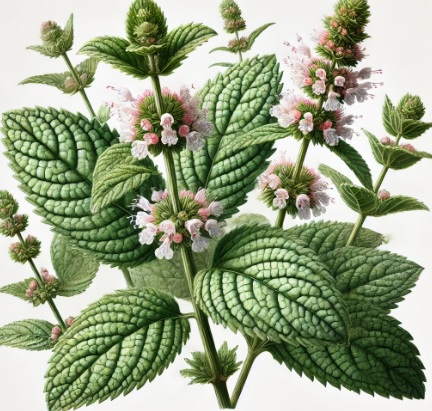Mentha Suaveolens, commonly known as Apple Mint, is a plant belonging to the Lamiaceae family. It is recognized for its aromatic leaves and is used in various applications due to its refreshing and pleasant fragrance.
Chemical Composition and Structure:
Menthol: Contributes a cooling sensation and a minty aroma.
Menthone: Adds a slightly different mint scent.
Linalool: Provides floral notes and enhances the overall fragrance.
Other Terpenes and Essential Oils: Includes various compounds that contribute to the distinctive scent and potential benefits of the plant.
Physical Properties:
Appearance: Typically, the plant has green, slightly hairy leaves and square stems, characteristic of the mint family.
Odor: Fresh, sweet, and fruity mint aroma.
Solubility: The essential oils from the plant are soluble in oils and alcohol; generally not soluble in water.
Production Process:
Cultivation: Mentha Suaveolens is cultivated in suitable conditions to ensure healthy growth and aromatic leaves.
Harvesting: The leaves are harvested when they are most aromatic, typically just before flowering.
Extraction (if applicable): Essential oils can be extracted using methods such as steam distillation or solvent extraction, though this may not always be necessary for all applications.
Formulation: The plant or its extracts can be used in various products, including cosmetics, culinary preparations, and aromatherapy.
Applications:
Cosmetics and Skincare: Used in products such as creams, lotions, and serums for its refreshing and aromatic properties.
Culinary Uses: Incorporated into recipes and dishes for its unique mint flavor.
Aromatherapy: Utilized in essential oil blends and diffusers for its soothing and pleasant aroma.
Environmental and Safety Considerations:
Environmental Impact: Sustainable cultivation practices are important to minimize environmental impact and ensure the quality of the plant.
Safety: Generally considered safe for use. As with all plant-based ingredients, individual sensitivities or allergic reactions may occur.
INCI:
Cosmetic astringent. This ingredient exerts a direct effect on the skin by tightening dilated pores by contracting stratum corneum cells and removing superfluous oil.
Skin conditioning agent. It is the mainstay of topical skin treatment as it has the function of restoring, increasing or improving skin tolerance to external factors, including melanocyte tolerance. The most important function of the conditioning agent is to prevent skin dehydration, but the subject is rather complex and involves emollients and humectants that can be added in the formulation.
Synonyms:
CAS:
![]() Mentha Suaveolens
Mentha Suaveolens 

